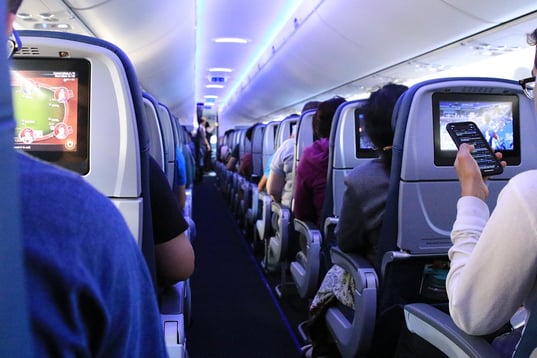
In Flight Entertainment and Connectivity: Past and Present
The term “IFEC” encompasses the numerous media and internet options which are available to passengers on commercial aircraft. The oldest and most easily recognizable example are in-flight movies, which have been available for decades. It has also been common for a while now to see embedded LCD displays for viewing video content on the back of headrests. But today, the selection of content to choose from is greater than ever, thanks to improvements in in-flight entertainment systems.
These advancements are partly due to increased data storage capacities for embedded IFEC systems, but the real game-changer was when audio and video on-demand (AVOD) became available via WI-FI on planes.
Wi-Fi on planes was originally aimed mainly at professionals traveling for business who wanted to be able to stay on top of emails and other work while in transit. Thanks to significant advances in wireless internet, data, and the rise of internet enabled personal electronic devices (PEDs), it has become a customer expectation that even on short flights, some degree of internet and media access will be included with the price of a ticket, or available a la carte for those willing to pay for it.
A key technological enabler of this IFEC revolution has been the increased use of High-Throughput Satellites operating in the Ku and Ka bands. For the time being, the Ku-band is much more widely used, and IFEC provider Gogo predicts that it will remain this way for the near future, but it is likely that Ka-band IFEC systems will become more common as more Ka-band constellations go online.
As a result of these improvements in mobile internet and satellite technology, the demand for IFEC overall has grown enormously over the past few years. As recently as 5 years ago, about half of passenger flights did not offer any form of wireless internet at all. Thanks to wireless AVOD, it’s really not even optional anymore. It is increasingly becoming a standard customer expectation, just like refreshments on a plane.
Current and Future Trends in In-Flight Entertainment
According to a report by Grand View Research, Inc., the global market for IFEC is expected to grow by almost $10 billion by 2024. Studying how IFEC systems and business models are currently being deployed and used gives us a clue as to how they will continue to evolve.
IFEC has become— and will continue to be— an increasingly important way for airlines to differentiate themselves from their competition. It is unlikely that one, single, IFEC business model will become universal. Rather, there will be a period of experimentation with different models as well as technologies and content offerings.
It is already the case that different tiers of IFEC experiences are available on the same planes based on seating class. The small, 7-9 inch embedded screens are and will remain popular in economy classes, while the business and first class sections have larger screens, and may include improvements like ultra-high definition 4K screens as they become available.
As the Internet of Things (IoT) era continues to unfold, no industry will be left untouched, and that includes aviation. The biggest area of IFEC growth will be in the wireless AVOD-to-PED market. Right now, some airlines charge for wireless AVOD, while others offer it for free. Still others pursue a hybrid model of offering free wireless access for simple web browsing and AVOD, while offering higher bandwidth paid options for large data-transfers and other uses oriented toward business.
Airlines are also developing their own mobile apps which will be used not only to book flights, but can be used to build and strengthen customer relationships by offering credits for upgraded IFEC experiences and also to earn additional income for the airline.
Interestingly, the availability of wireless AVOD-to-PED has not eliminated the demand for embedded IFEC devices. Rather, they will coexist in the future, and airlines will experiment to find the combinations that is able to provide the best passenger experience. (Source)
As in flight entertainment, internet, and connectivity continue to improve and customer expectations continue to rise, you’ll want to make sure you have the best information and most skilled firms on your side if you want a piece of this $10-billion-dollar market. We make it our business to stay on top the latest news and future trends in all the markets we serve. Learn more about our innovate designs and cutting edge solutions for the aviation market and more.







